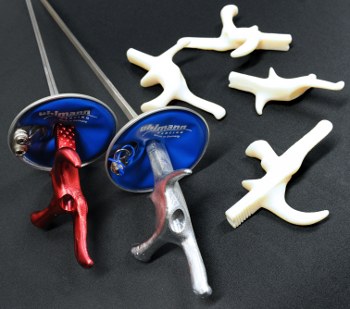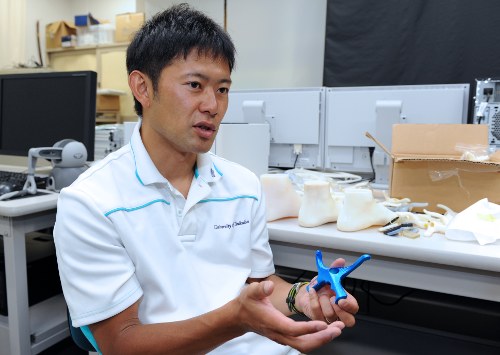 |
| September 24, 2013 | Volume 09 Issue 36 |
Designfax weekly eMagazine
Archives
Partners
Manufacturing Center
Product Spotlight
Modern Applications News
Metalworking Ideas For
Today's Job Shops
Tooling and Production
Strategies for large
metalworking plants
Personalized swords helped the Japanese fencing team take silver in 2012 Olympics

Personalized fencing hilts produced on a multi-material Objet350 Connex 3D printer.
The University of Tsukuba, Japan, is using an Objet350 Connex multi-material 3D printer as part of its advanced R&D program for sports science and Olympic training.
The university conducts research and development in three key areas: sports equipment, training, and conditioning. A research team led by Professor Norihisa Fujii at the university's Faculty of Gymnastics developed equipment used by Japan's fencing team, which won the silver medal in the 2012 London Olympics.
3D printing helps fencers get a grip
The hilt of the fencing sword must fit the fencer's hand perfectly; even a slight difference in the shape of the hilt can spell victory or defeat. Before 3D printing, there was only one type of fencing hilt in the world, and each competitor had to personally file the hilt to customize the fit and achieve a non-slip surface. If the sword ended up breaking, it was almost impossible to get another one with the same fit.
For the 2012 Olympics, the University of Tsukuba researchers scanned the actual equipment used by the fencers in 3D, and the resulting polygon data was then incorporated into 3D CAD. The 16-micron accuracy of the PolyJet-based Objet350 Connex 3D Printer enabled the researchers to produce iterative prototypes of each sword with minute variations according to the athlete's feedback. A total of 70 prototypes were produced.
"Players are not engineers," says Mr. Osamu Takeda, a researcher who managed the modeling of the prototypes at the University of Tsukuba, Sports R&D Core. "They talk about their requirements instinctively. So, bearing this in mind, we develop various patterns based on different assumptions. With the Objet Connex multi-material 3D printer, we can do this easily. We can respond flexibly and promptly because the machine is so accurate."

Researcher Osamu Takeda, who managed the prototype modeling process.
The customized, completed hilts were manufactured in April 2012, three months before the London Olympics. For the first time in fencing history, each competitor had five spare hilts, providing an extra sense of security.
"Whatever the sport may be, it's all about designing customized equipment to enable the athlete to maximize his or her personal best," says Jon Cobb, executive vice president marketing, Stratasys. "Stratasys 3D printers have a long history with the sports world, spanning everything from the design of customized running shoes to the 3D printing of end-use parts for bikes and snowmobiles. The accuracy of our technology and the durability and flexibility of our materials enable sports equipment designers to develop truly breakthrough concepts. Also, the fast turnaround time of 3D printing means that the athlete can try several design iterations until the equipment exactly matches personal preferences."
The University of Tsukuba is now exploring other 3D-printing sports applications, such as protective equipment for gymnasts, shoes for javelin throwers, triathlon wear, sailing masts, a footwork assessment system for badminton, and more.
Source: Stratasys
Published September 2013
Rate this article
View our terms of use and privacy policy
